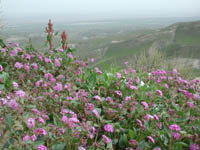
Ammophila is a genus of flowering plants consisting of two or three very similar species of grasses. The common names for these grasses include marram grass, bent grass, and beachgrass. These grasses are found almost exclusively on the first line of coastal dunes. Their extensive systems of creeping underground stems or rhizomes allow them to thrive under conditions of shifting sands and high winds, and to help stabilize and prevent coastal erosion. Ammophila species are native to the coasts of the North Atlantic Ocean where they are usually the dominant species on dunes. Their native range includes few inland regions, with the Great Lakes of North America being the main exception. The genus name Ammophila originates from the Greek words ἄμμος (ámmos), meaning "sand", and φίλος (philos), meaning "friend".

Mirabilis is a genus of plants in the family Nyctaginaceae known as the four-o'clocks or umbrellaworts. The best known species may be Mirabilis jalapa, the plant most commonly called four o'clock.

Nyctaginaceae, the four o'clock family, is a family of around 33 genera and 290 species of flowering plants, widely distributed in tropical and subtropical regions, with a few representatives in temperate regions. The family has a distinctive fruit type called an accessory fruit or anthocarp, and many genera have extremely large pollen grains.

Physocarpus, commonly called ninebark, is a genus of flowering plants in the family Rosaceae, native to North America and northeastern Asia.

Pisonia is a genus of flowering plants in the four o'clock flower family, Nyctaginaceae. It was named for Dutch physician and naturalist Willem Piso (1611–1678). Certain species in this genus are known as catchbirdtrees, birdcatcher trees or birdlime trees because they catch birds. The sticky seeds are postulated to be an adaptation of some island species that ensures the dispersal of seeds between islands by attaching them to birds, and also allows the enriching of coralline sands. These island species include P. brunoniana of Australasia and Polynesia and P. umbellifera, which is widespread in the tropical Indo-Pacific region.

Lippia is a genus of flowering plants in the verbena family, Verbenaceae. It was named after Augustin Lippi (1678–1705), a French naturalist and botanist. He was killed in Abyssinia. The genus contains roughly 200 species of tropical shrubs that are found around the world. Plants are fragrant due to their essential oils, which vary between species but may include estragole, carvacrol, linalool or limonene. The leaves of certain species, such as L. graveolens, can be used as a culinary herb similar to oregano.
Coastal strand is a plant community of flowering plants that form along the shore in loose sand just above the high tide line.

Forestiera is a genus of flowering plants in the olive family, Oleaceae. Members of the genus are often called swampprivets. Most are shrubs.

Abronia villosa is a species of sand-verbena known by the common names desert sand-verbena and chaparral sand-verbena. It is in the four o'clock plant family (Nyctaginaceae). It is native to sandy areas in the deserts of the southwestern United States and northern Mexico, associated with creosote-bush and coastal-sage scrub habitats.

Abronia alpina is a rare species of flowering plant in the four o'clock family known by the common names Ramshaw Meadows sand verbena and Ramshaw Meadows abronia. It is endemic to Tulare County, California, where it is known from only one area high in the Sierra Nevada.

Abronia pogonantha is a species of flowering plant in the four o'clock family (Nyctaginaceae) known by the common name Mojave sand-verbena. It is native to California and Nevada, where it grows in the Mojave Desert, adjacent hills and mountains, and parts of the San Joaquin Valley in the Central Valley.

Abronia ammophila, the Yellowstone sand verbena, or Wyoming sand verbena, is a plant unique to Yellowstone National Park lakeshores and is endemic to the park. Part of the "Four o'clock" family (Nyctaginaceae), the abronia ammophila is best suited in sandy soils and lake shores.

Abronia ameliae, commonly known as Amelia's sand verbena or heart's delight, is a species of flowering plant in the Four O'clock family, Nyctaginaceae, that is endemic to southern Texas in the United States. It inhabits grasslands in the deep sands of the Holocene sand sheet, which is part of the Tamaulipan mezquital. This species was named for Amelia Anderson Lundell, wife of Cyrus Longworth Lundell.

Abronia mellifera, the white sand verbena, is a herbaceous perennial flowering plant in the Nyctaginaceae family. It is endemic to the northwestern United States.

Abronia fragrans, the sweet sand-verbena, snowball sand-verbena, prairie snowball or fragrant verbena, is a species of sand verbena.

Tripterocalyx is a small genus of flowering plants in the four o'clock family, Nyctaginaceae. It contains four species formerly included in the closely related genus Abronia, the sand-verbenas. These plants are native to North America, especially the dry desert southwest of the United States. They bloom in heads of several colorful trumpet-shaped flowers. Sandpuffs or sand-verbenas are common names for plants in this genus.
Tripterocalyx crux-maltae is a species of flowering plant in the four o'clock family known by the common names Lassen sandverbena and Kellogg's sand-verbena.

Abronia macrocarpa is a rare species of flowering plant known by the common name largefruit sand verbena. It is endemic to eastern Texas, where its current range is limited to Freestone, Leon, and Robertson counties. It inhabits harsh, open sand dunes on savannas, growing in deep, poor soils. It was first collected in 1968 and described as a new species in 1972. It is a federally listed endangered species of the United States.

Phemeranthus (fameflower) is a genus of flowering plants in the miner's lettuce family, Montiaceae, native to the Americas. It is sometimes placed in Portulacaceae. The name is derived from the Greek words εφήμερος (ephemeros), meaning "living for one day," and ἄνθος (anthos), meaning "flower." Common names for the various species are often fame flower, rock rose, rock pink, and sand pink.

































